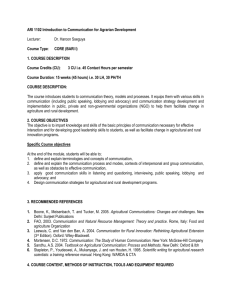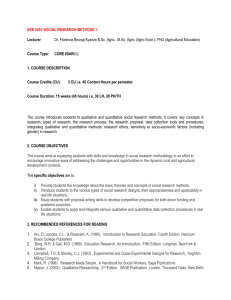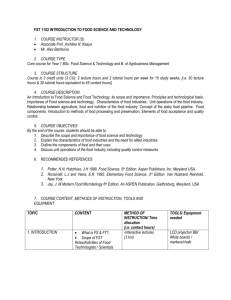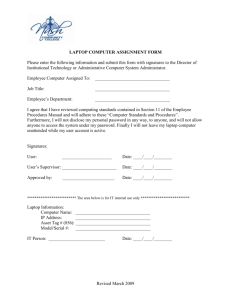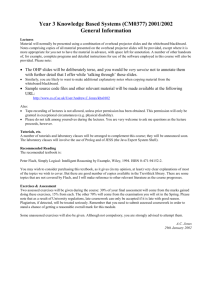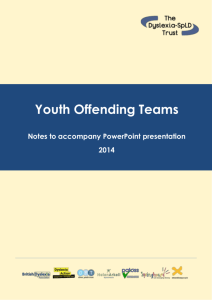AGE 7103 PROGRAM DEVELOPMENT AND EVALUATION
advertisement
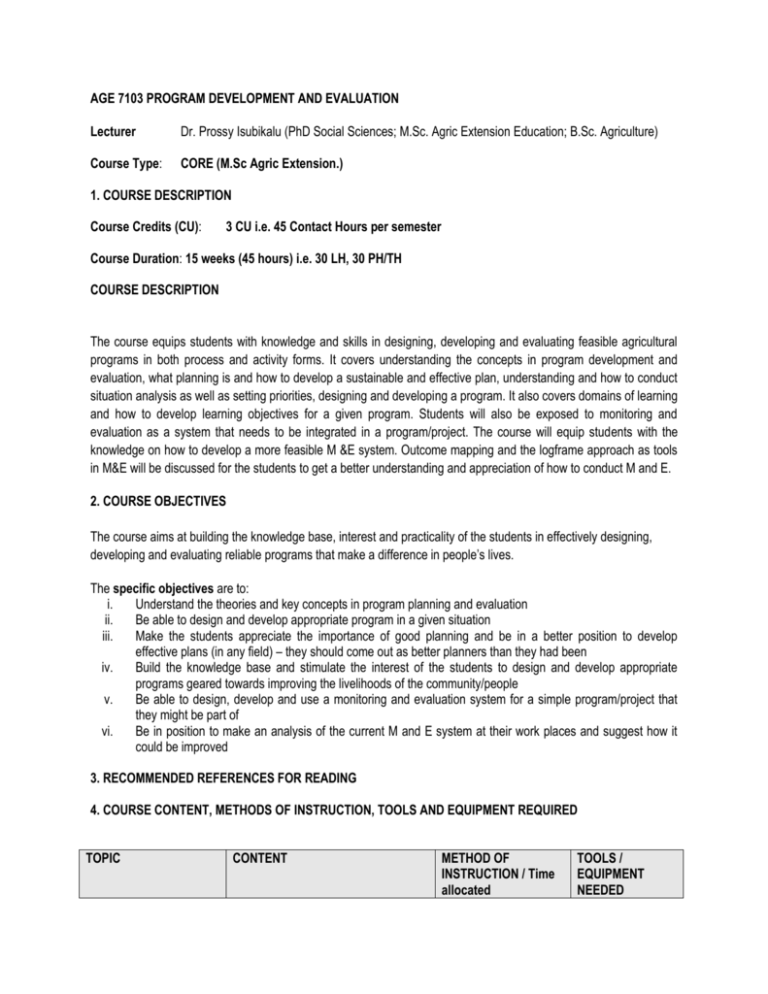
AGE 7103 PROGRAM DEVELOPMENT AND EVALUATION Lecturer Dr. Prossy Isubikalu (PhD Social Sciences; M.Sc. Agric Extension Education; B.Sc. Agriculture) Course Type: CORE (M.Sc Agric Extension.) 1. COURSE DESCRIPTION Course Credits (CU): 3 CU i.e. 45 Contact Hours per semester Course Duration: 15 weeks (45 hours) i.e. 30 LH, 30 PH/TH COURSE DESCRIPTION The course equips students with knowledge and skills in designing, developing and evaluating feasible agricultural programs in both process and activity forms. It covers understanding the concepts in program development and evaluation, what planning is and how to develop a sustainable and effective plan, understanding and how to conduct situation analysis as well as setting priorities, designing and developing a program. It also covers domains of learning and how to develop learning objectives for a given program. Students will also be exposed to monitoring and evaluation as a system that needs to be integrated in a program/project. The course will equip students with the knowledge on how to develop a more feasible M &E system. Outcome mapping and the logframe approach as tools in M&E will be discussed for the students to get a better understanding and appreciation of how to conduct M and E. 2. COURSE OBJECTIVES The course aims at building the knowledge base, interest and practicality of the students in effectively designing, developing and evaluating reliable programs that make a difference in people’s lives. The specific objectives are to: i. Understand the theories and key concepts in program planning and evaluation ii. Be able to design and develop appropriate program in a given situation iii. Make the students appreciate the importance of good planning and be in a better position to develop effective plans (in any field) – they should come out as better planners than they had been iv. Build the knowledge base and stimulate the interest of the students to design and develop appropriate programs geared towards improving the livelihoods of the community/people v. Be able to design, develop and use a monitoring and evaluation system for a simple program/project that they might be part of vi. Be in position to make an analysis of the current M and E system at their work places and suggest how it could be improved 3. RECOMMENDED REFERENCES FOR READING 4. COURSE CONTENT, METHODS OF INSTRUCTION, TOOLS AND EQUIPMENT REQUIRED TOPIC CONTENT METHOD OF INSTRUCTION / Time allocated TOOLS / EQUIPMENT NEEDED 1. Introduction to Program planning and evaluation 2. Understanding effective planning Introduction of the course Generation of students expectations Discussion of the expectations in line with the objectives Getting a common understanding of key concepts (program, project, planning, evaluation) Difference and similarity between project and program project Understanding the concept of planning and planners Planning principles Important skills in planning Importance or significance of planning Interactive Lectures – drawing from experience among the students (4 hrs) Reading assignment Interactive Lectures (3hrs) Tutorial 1 hour Interactive Lectures Sustainable planning and group exercises (4 Effective planning Kinds/types of planning (standard hrs) or repeated use plans, single use Tutorial 1 hour plan 4. Situation analysis Understanding situation analysis and its importance steps in conducting situation analysis, involving people and its significance Analyzing a problem (problem analysis techniques) 5. Priority setting 6. Designing and developing a What priority setting is Why and when priority setting is done Flash cards, Markers White Board, Laptop, LCD Projectors, Paper Reading Assignment 3. Sustainable and effective planning Flash cards, Markers White Board, Laptop, LCD Projectors, Paper Interactive Lecture (3hrs) Markers White Board, Laptop, LCD Projectors Paper Markers White Board, Laptop, LCD Projector, Tutorials 2 hours Take home Assignment Interactive Lectures (3hrs) Tutorials 1 hour Markers White Board, Laptop, LCD Projector, software Considerations in priority setting Understanding program development process Logical models in developing Interactive Lectures (4hrs) Markers White Board, Laptop, LCD Projector, program programs Program designing Review of objective and goal Tutorials 2 hours 7. Domains of learning The cognitive domain The affective domain The psychomotor domain Interactive Lectures (4hrs) Markers White Board, Laptop, LCD Projector, Desktop computers 8. Developing and using learning objectives What is a learning objective? Why use learning objectives? Developing learning objectives Parts of behavioral objectives Interactive Lectures (4hrs) Markers White Board, Laptop, LCD Projector, Understanding of the concepts of monitoring and evaluation Difference and relationship between monitoring and evaluation Significance of monitoring Types of monitoring 9. Monitoring and Evaluation 10. Evaluation 11. setting up a monitoring and evaluation system 12. Tools in M and E Reading Assignment Tutorial 1 hour Interactive Lectures (2hrs) significance of evaluation types and sub-types of evaluation (formative – process and progress evaluation; summative – outcome and impact evaluation) comparing conventional and participatory evaluation characteristics of an effective M and E Interactive Lectures (2hrs) seeing M and E as an integrated system Linking M and E in a project Key steps in linking up and M and E system Scope of M and E Performance questions and indicators 5 hours The Logframe approach The logframe matrix The vertical and horizontal logic Analysing the logframe o Criticisms of thelogframe o Positives about the 3 hours Markers White Board, Laptop, LCD Projector Markers White Board, Laptop, LCD Projector, Tutorials 2 hours Markers White Board, Laptop, LCD Projector, Tutorials 1 hour Tutorials 2 hours Markers White Board, Laptop, LCD Projector, logframe 13. Outcome mapping (OM) Introduction to OM as a tool in monitoring and evaluation Definition of key concepts Principles of outcome mapping (OM) Relationship between objectives, outputs & outcomes Stages & steps in outcome mapping How OM works - When does OM work best How to support outcome mapping Criticisms and strengths of OM 5. SUMMARY OF TIME NEEDED Interactive lectures covering theory Tutorial Hours 45 hrs 15 hrs 6. OVERALL COURSE EVALUATION Continuous Assessment Test Take Home and group assignment Final examination 20% 20% 60%. END 4 hours Tutorials 2 hours Markers White Board, Laptop, LCD Projector,
